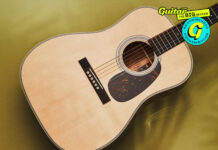
Cory Wong explains his “steady motor” method to keep his picking hand in time
When you first start learning guitar, it’s probably true that you give more attention to what your fingering hand is doing than your picking hand. But the latter is in charge of timing, so it mustn’t be overlooked.
Given the importance of rhythm and timing, many guitarists devise methods to make sure their right hand remains steady and to the beat, like Cory Wong, who in a new column for Guitar World, explains his “steady motor” method.
READ MORE: Kirk Hammett used a guitar made by Gibson’s CEO for Metallica’s Black Sabbath farewell performance – and it’s heading to auction
“I’d like to talk about the paramount importance of the right, or pick, hand,” he explains. “How it’s the keeper of time and the thing that gives us the groove while we play.”
“When it comes to strumming,” he continues, “I subscribe to the ‘steady motor’ method, keeping my hand in perpetual motion, in an unbroken down-up ‘pendulum pattern, most often in a 16th-note rhythm, even when I’m not hitting every 16th note…
“…This way, I never have to think about my strokes, as the continuous motion will make those decisions for me.”
Indeed, you’ll notice what Cory Wong’s talking about if you watch any video of him performing live; his right hand remains in steady motion, regardless of the rhythmic intervals between the actual notes he’s playing.
Like anything, though, a method that works for one situation won’t necessarily work for every situation.
“Are there times when I’ll change my strumming approach for a unique musical situation? Absolutely – this is just a general guideline.
Cory Wong kicked up some dirt in the guitar world lately when he made his opinion clear that guitarists should know every note on their fretboard.
His comments sparked heated debate online – which he wasn’t opposed to, by any stretch. “Didn’t know this would trigger so many folks,” he said. “I’m here for it.”
The post Cory Wong explains his “steady motor” method to keep his picking hand in time appeared first on Guitar.com | All Things Guitar.
Source: www.guitar-bass.net












